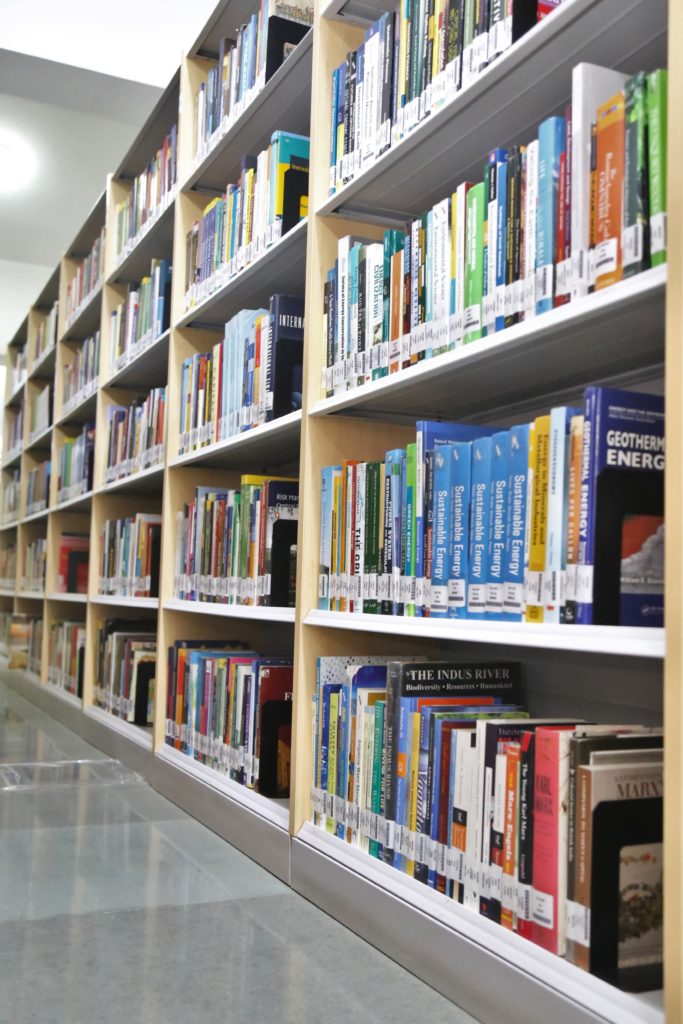Sustainability Courses
Development of graduate and undergraduate courses and programmes on sustainability at IITGN.

Development of graduate and undergraduate courses and programmes on sustainability at IITGN.
The central theme of this course is to teach earth materials and processes, including structure of solid Earth, rock cycle, types of rocks and its engineering properties, soils: processes of formation, soil profile and soil types, Geophysical methods of earth characterization, concept of plate tectonics, sea-floor spreading and continental drift, Origin of oceans, continents, mountains and rift valleys, Earthquake and earthquake belts; Dynamic behavior of Earth Surface and role of hydrosphere: River processes, Surface water hydrology, Hillslope processes, catchment erosion processes, Coastal Processes, Groundwater and karst processes; Applications in Civil Engineering and Environmental Management. Examples of experiments included in the course are study of physical properties of minerals and rocks in hand specimens, study of topographic sheets and analysis of hillslope and watershed features, drawing profile sections and interpretation of geological maps of different complexities.
This course introduces the concept of sustainability covering several areas such as humanity and environment, the evolution of environmental policy, climate and global change, climate processes: external and internal controls, modern climate change, climate projections, biosphere, soil and sustainability, biodiversity and ecosystem functions, physical resources: water, pollution, minerals, environmental and resource economics, modern environmental management, systems of waste management, sustainable energy systems, sustainable infrastructure, embodied energy, life cycle, sustainable materials and construction, problem solving and tools of sustainability.
The course introduces hydraulic and hydrologic processes including control volume approach, continuity, energy, momentum, introduction to hydrology, precipitation, evaporation, and infiltration, surface runoff, streamflow routing; and provides an introduction to pipe flow, open channel flow and groundwater flow.
The course delivers an overview of remote sensing, electromagnetic radiation principles, remote sensing data collection, geometric correction, image enhancement, image interpretation, image classification, band transformation, thermal infrared remote sensing, change detection, feature extraction, monitoring of land and water resources, accuracy assessment, remote sensing of soil, vegetation, water, and urban areas, object oriented classification, and spectral indices.
Various topics such as hydroclimatology, water balance, understanding hydrologic change, statistical representation of hydrologic data, flood frequency analysis, understanding frequency of droughts, hydrologic design, hydrologic time series analysis, parametric and non-parametric trends, spectral analysis, wavelet analysis, uncertainty analysis, hydrologic modeling, and hydrologic forecasting are covered in this course.
The course deals with Water Resource System modeling: System Components, Planning and Management, modeling of water resource systems, supply and demand Curves. Introduction to optimization for water resource systems with an introduction to modeling constraints in water resource planning and management, linear programming solution strategies and stochastic programming for reservoir operation problem; applications in water resource management, network modeling for water resource systems and river basin planning and floodplain management including screening models, floodplain management, urban stormwater management, integrated water resource management frameworks, and best practices and opportunities in resilient design.
The course offers an overview of air pollution, including types of air pollutants; common sources; health and environmental impacts of air pollutants; the global and national context of air pollution: evolution of policies and regulations and the current status, discusses Particulate Matter (PM) and associated properties, principles and transmission, sulphur oxides and nitrogen oxides, volatile organic compounds (VOCs), ozone and global warming effects of CO2; CO2 capture technologies; overview of CO2 sequestration; atmospheric chemistry of ozone and interplay with other pollutants; photochemical smog, and Air pollution and meteorology. Other topics covered include mercury control, mobile sources (motor vehicles): IC engine and diesel engine operation, air-fuel ratio, formation of pollutants, catalytic converter; indoor air quality: differences from outdoor air, sources, material balance.
The course covers a range of topics related to solar photovoltaics, including Photovoltaic (PV) history, PV economics, Solar energy conversion; Physics: Crystal structures, atomic bonding, types of semiconductors, energy band diagram, p-type and n-type semiconductors, doping and carrier concentration, diffusion and drift of carriers, continuity equation, P-N junction and its properties, dark I-V equation of P-N junction, junction under illumination, solar cell parameters, measurements of solar cell parameters, short circuit current, open circuit voltage, fill factor, cell efficiency, optical losses, electrical losses, surface recombination velocity, quantum efficiency, I-V characteristics; Technologies: Crystalline/Poly-Crystalline silicon solar cell technologies, Amorphous silicon solar cell technology, Thin film solar cell technologies, Characterization of solar cell materials and devices, Nanostructured solar cells; Applications: System components; Cells, modules and arrays; Interfacing PV modules to loads; Power Conditioning and Maximum Power Point Tracking (MPPT) Algorithms; Inverter control topologies for stand-alone and grid-connected operation; Stand-alone PV systems, Grid-connected (utility interactive) PV systems.
The course introduces river science, geomorphic concepts, river basin approach, drainage network, river processes and morphology; hydrological, sedimentological and ecological characteristics and their interrelationship in different channel patterns; dynamics of alluvial rivers; different classification approaches in fluvial geomorphology and its applications, glacio-fluvial interaction, river response to climate, tectonics and human disturbance, ecosystem based approach to stream management, concept of river health and environmental flow (e-flow).
A study of Dynamical Earth’s System, Earth system components, Processes and characteristics of different earth components, Interaction between Earth’s components: mass and energy exchanges, Biogeochemical cycles, Coevolution of life and Earth’s planet, Anthropocene, Models of earth system, Prediction and uncertainties including Sensitivities, Uncertainties in earth system, risk, management, sustainability, Environmental management in high risk and high uncertain systems.
This course introduces river science, geomorphic concepts, river basin approach, drainage network, river processes and morphology; hydrological, sedimentological and ecological characteristics and their interrelationship in different channel patterns; dynamics of alluvial rivers; different classification approaches in fluvial geomorphology and its applications, glacio-fluvial interaction, river response to climate, tectonics and human disturbance, ecosystem based approach to stream management, concept of river health and environmental flow (e-flow).
The course explains the purpose of mathematical modeling in Earth system science and its methodology; mathematical representation of the Earth system and its components; Equilibrium algebraic models: energy and mass balance at earth’s surface, Thermodynamics and chemical reactions in Earth system; Growth and decay ODE models: Biogeochemical cycles; Transport process PDE models: Advection and diffusion processes in the Earth system; Distribution of events: Probability distribution of disaster events; Control of risks in earth system: Optimization models, sustainability models; Numerical algorithms.
This course provides an overview of elements and levels of biodiversity and its significance, biodiversity conservation, ecosystems and ecosystem diversity, policies and legal framework for obtaining environmental clearances for developmental projects; Biodiversity conservation and Sustainable Development – Concept, United Nations Sustainable Development Goals and Targets; Biodiversity conservation and community; Stakeholders, Social, Economic and Political process vis a vis Conservation; Sustainable Development for a wildlife landscape – Man-animal conflicts, wildlife friendly infrastructure and development; Dependence of local communities on Natural resources; Joint Forest Management, and participatory approaches to the management of Forests and Wildlife.
This course is an introduction to the system and economic tools for energy systems; Conventional Power Generation Technology with the related Fundamentals; Renewable and Emerging Clean Energy Systems and Technologies; Solar Thermal Energy Technology; Photovoltaic Technology; Hydro-Power, Wind, Geothermal, Marine, and Biomass Energy Systems; Advanced Energy Storage; Oxyfuel Combustion, Carbon Capture and Storage, Cleaner Coal Technologies.
This course is based on fundamental theory and application of the physical and chemical processes in water and wastewater treatment: Introduction to water quality parameters, standards, Fundamentals, optimization and design of various processes for water treatment: Sedimentation, Softening, Disinfection, Reactor design, Ozone contactor design, Air stripping, Membrane Processes, and Ion exchange.
The course offers foundational knowledge of Environment and Society: changing notions of nature/environment, human impacts on environments and vice versa; Colonialism and environment: mis/use of natural resources and green imperialism; Conservation and development: contradictory relations with environment, ecological equity and justice. Human-animal relations: trust and domination, animal icons and animals in urban society. Environmental movements: local struggles, resource control, social inequity and injustice. Green capitalism and neoliberal environmentalism: markets and commodification of nature.
This course covers a range of issues from Archaeology to Ethnography of use of stone, ceramic and glass in pre-modern India. This course alerts students to the contextual nature of technologies and how different societies respond to different needs within the environmental, material and cultural constraints and involves a number of experimental studies and visits to the surviving traditional industries. History of Ancient Indian technology; Surviving traditional technologies in India; Raw materials used in Palaeolithic Technology: Rocks; Palaeolithic Technology: Evolution of stone tools through time; Stone working: Stone objects (grinding stone, beads etc.); Shell, Bone and Antler Working; Ceramic Production: Pottery and Terracotta; Glass Making and Working; Furnaces/Kilns; The carriers of our heritage are also discussed.
This course studies desalination processes, transport phenomena, thermodynamics, entropy generation minimization for improving energy efficiency, Non-Equilibrium Thermodynamics overview, Entropy generation description based on non-equilibrium thermodynamics, Principle of equipartition of entropy generation, Case studies on application of equipartition to design: (1) flow-balancing, (2) multi staging.
